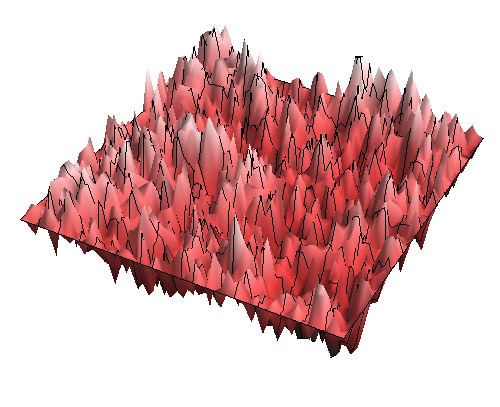 | ||
In probability theory and statistical mechanics, the Gaussian free field (GFF) is a Gaussian random field, a central model of random surfaces (random height functions). Sheffield (2007) gives a mathematical survey of the Gaussian free field.
Contents
The discrete version can be defined on any graph, usually a lattice in d-dimensional Euclidean space. The continuum version is defined on Rd or on a bounded subdomain of Rd. It can be thought of as a natural generalization of one-dimensional Brownian motion to d time (but still one space) dimensions; in particular, the one-dimensional continuum GFF is just the standard one-dimensional Brownian motion or Brownian bridge on an interval.
In the theory of random surfaces, it is also called the harmonic crystal. It is also the starting point for many constructions in quantum field theory, where it is called the Euclidean bosonic massless free field. A key property of the 2-dimensional GFF is conformal invariance, which relates it in several ways to the Schramm-Loewner Evolution, see Sheffield (2005) and Dubédat (2007).
Similarly to Brownian motion, which is the scaling limit of a wide range of discrete random walk models (see Donsker's theorem), the continuum GFF is the scaling limit of not only the discrete GFF on lattices, but of many random height function models, such as the height function of uniform random planar domino tilings, see Kenyon (2001). The planar GFF is also the limit of the fluctuations of the characteristic polynomial of a random matrix model, the Ginibre ensemble, see Rider & Virág (2007).
The structure of the discrete GFF on any graph is closely related to the behaviour of the simple random walk on the graph. For instance, the discrete GFF plays a key role in the proof by Ding, Lee & Peres (2012) of several conjectures about the cover time of graphs (the expected number of steps it takes for the random walk to visit all the vertices).
Definition of the discrete GFF
Let P(x, y) be the transition kernel of the Markov chain given by a random walk on a finite graph G(V, E). Let U be a fixed non-empty subset of the vertices V, and take the set of all real-valued functions
Then, the random function with probability density proportional to
It is not hard to show that the expected value
So, in one sentence, the discrete GFF is the Gaussian random field on V with covariance structure given by the Green's function associated to the transition kernel P.
The continuum field
The definition of the continuum field necessarily uses some abstract machinery, since it does not exist as a random height function. Instead, it is a random generalized function, or in other words, a distribution on distributions (with two different meanings of the word "distribution").
Given a domain Ω ⊆ Rn, consider the Dirichlet inner product
for smooth functions ƒ and g on Ω, coinciding with some prescribed boundary function on
The continuum GFF
Such a random field indeed exists, and its distribution is unique. Given any orthonormal basis
where the
hence
is a well-defined finite random number.
Special case: n = 1
Although the above argument shows that
and then
On the other hand, for
Special case: n = 2
In dimension n = 2, the conformal invariance of the continuum GFF is clear from the invariance of the Dirichlet inner product.
